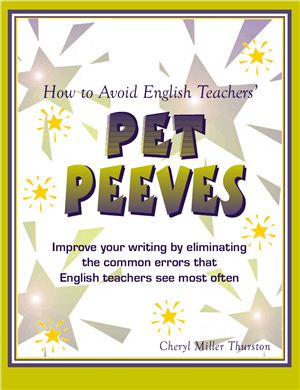Cottonwood Press, Inc, 2001, ISBN: 187767351X, 168 pages, PDF, 1,2
MB.
HOW TO AVOID ENGLISH TEACHERS' PET PEEVES is a book that helps writers avoid the annoying little errors that English teachers encounter nearly every day as they read student papers. It addresses the mistakes that make English teachers wince or, on really bad days, want to give up teaching and embark on a career selling real estate or life insurance. It is not intended to address major problems, like disorganized writing or writing that doesn't make sense.
English teachers are not unreasonably persnickety. They just love words and like to see them used correctly. In college, they major in English because they love reading and writing. Then they become teachers and see their beloved language mangled countless times a day, day after day. Seeing "a lot" misspelled once isn't so bad. Seeing it misspelled as "alot" 57 times in one week does tend to ruin a teacher's sense of perspective.
The pet peeves included in HOW TO AVOID ENGLISH TEACHERS' PET PEEVES were chosen in a survey of 125 English teachers from across the United States. The author uses a sense of humor and short, sensible explanations to help anyone, grade 5 and older, lea to avoid common writing errors. She has 30 years of experience as a teacher (grades 7 through uni-versity), writer and editor.
The book is part of the Cottonwood Press "Teaching the Boring Stuff" series.
HOW TO AVOID ENGLISH TEACHERS' PET PEEVES is a book that helps writers avoid the annoying little errors that English teachers encounter nearly every day as they read student papers. It addresses the mistakes that make English teachers wince or, on really bad days, want to give up teaching and embark on a career selling real estate or life insurance. It is not intended to address major problems, like disorganized writing or writing that doesn't make sense.
English teachers are not unreasonably persnickety. They just love words and like to see them used correctly. In college, they major in English because they love reading and writing. Then they become teachers and see their beloved language mangled countless times a day, day after day. Seeing "a lot" misspelled once isn't so bad. Seeing it misspelled as "alot" 57 times in one week does tend to ruin a teacher's sense of perspective.
The pet peeves included in HOW TO AVOID ENGLISH TEACHERS' PET PEEVES were chosen in a survey of 125 English teachers from across the United States. The author uses a sense of humor and short, sensible explanations to help anyone, grade 5 and older, lea to avoid common writing errors. She has 30 years of experience as a teacher (grades 7 through uni-versity), writer and editor.
The book is part of the Cottonwood Press "Teaching the Boring Stuff" series.

